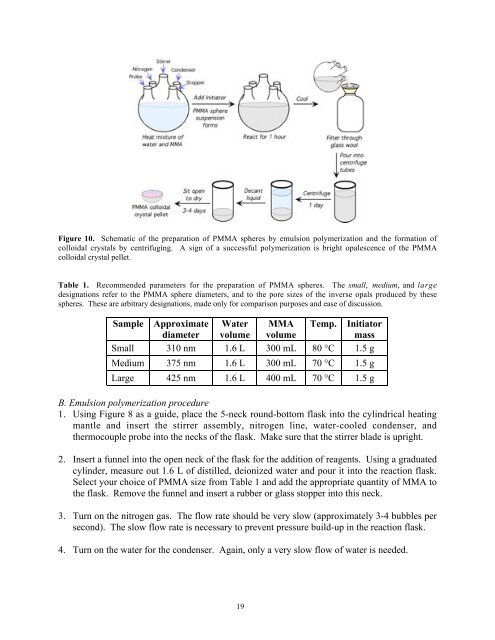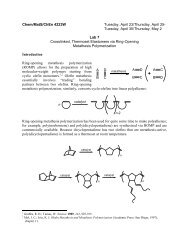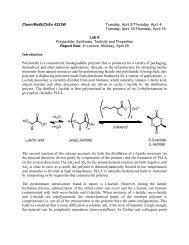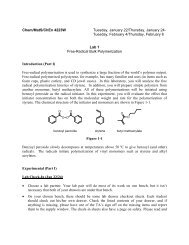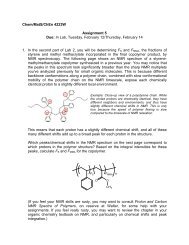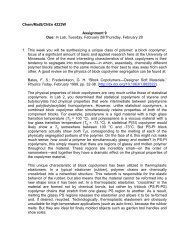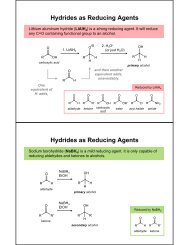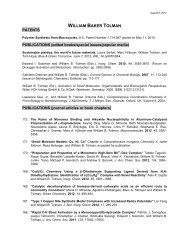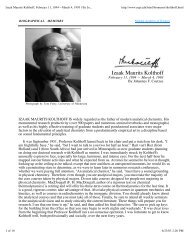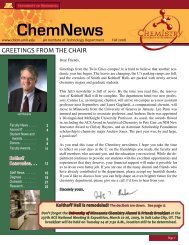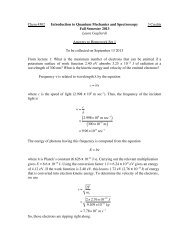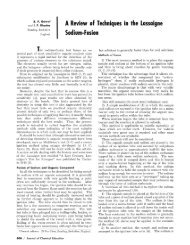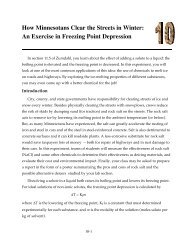Inverse Opal Photonic Crystals - Department of Chemistry ...
Inverse Opal Photonic Crystals - Department of Chemistry ...
Inverse Opal Photonic Crystals - Department of Chemistry ...
You also want an ePaper? Increase the reach of your titles
YUMPU automatically turns print PDFs into web optimized ePapers that Google loves.
Figure 10. Schematic <strong>of</strong> the preparation <strong>of</strong> PMMA spheres by emulsion polymerization and the formation <strong>of</strong><br />
colloidal crystals by centrifuging. A sign <strong>of</strong> a successful polymerization is bright opalescence <strong>of</strong> the PMMA<br />
colloidal crystal pellet.<br />
Table 1. Recommended parameters for the preparation <strong>of</strong> PMMA spheres. The small, medium, and large<br />
designations refer to the PMMA sphere diameters, and to the pore sizes <strong>of</strong> the inverse opals produced by these<br />
spheres. These are arbitrary designations, made only for comparison purposes and ease <strong>of</strong> discussion.<br />
Sample Approximate<br />
diameter<br />
Water<br />
volume<br />
MMA<br />
volume<br />
Temp. Initiator<br />
mass<br />
Small 310 nm 1.6 L 300 mL 80 °C 1.5 g<br />
Medium 375 nm 1.6 L 300 mL 70 °C 1.5 g<br />
Large 425 nm 1.6 L 400 mL 70 °C 1.5 g<br />
B. Emulsion polymerization procedure<br />
1. Using Figure 8 as a guide, place the 5-neck round-bottom flask into the cylindrical heating<br />
mantle and insert the stirrer assembly, nitrogen line, water-cooled condenser, and<br />
thermocouple probe into the necks <strong>of</strong> the flask. Make sure that the stirrer blade is upright.<br />
2. Insert a funnel into the open neck <strong>of</strong> the flask for the addition <strong>of</strong> reagents. Using a graduated<br />
cylinder, measure out 1.6 L <strong>of</strong> distilled, deionized water and pour it into the reaction flask.<br />
Select your choice <strong>of</strong> PMMA size from Table 1 and add the appropriate quantity <strong>of</strong> MMA to<br />
the flask. Remove the funnel and insert a rubber or glass stopper into this neck.<br />
3. Turn on the nitrogen gas. The flow rate should be very slow (approximately 3-4 bubbles per<br />
second). The slow flow rate is necessary to prevent pressure build-up in the reaction flask.<br />
4. Turn on the water for the condenser. Again, only a very slow flow <strong>of</strong> water is needed.<br />
19


